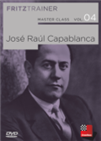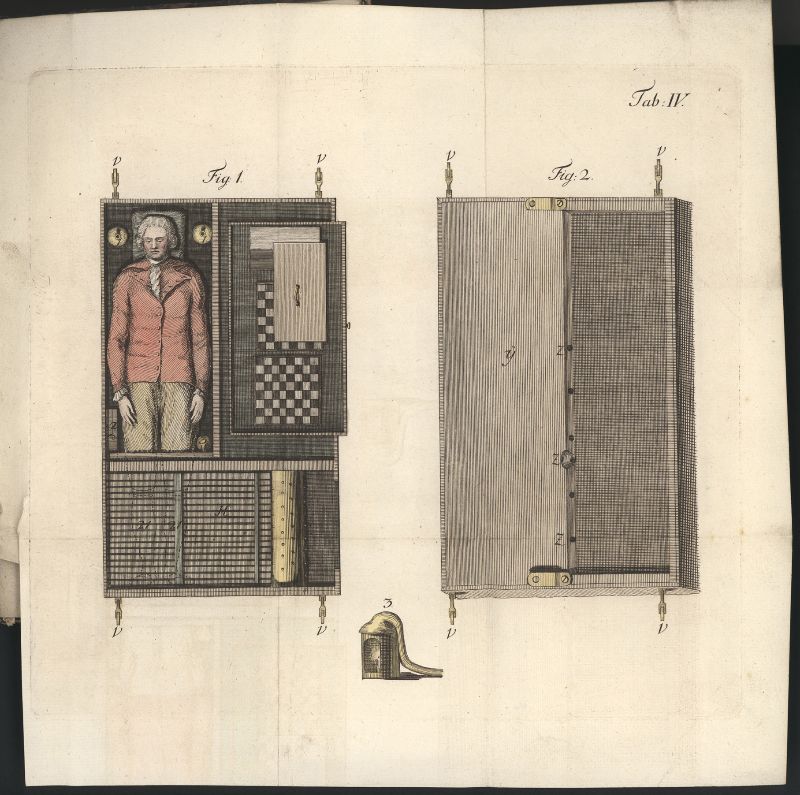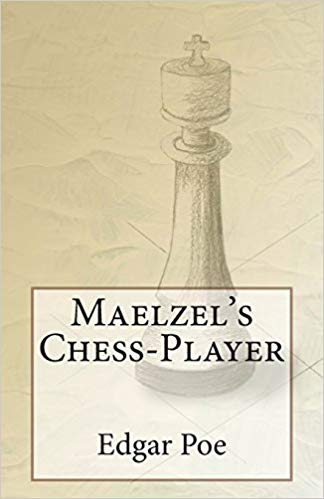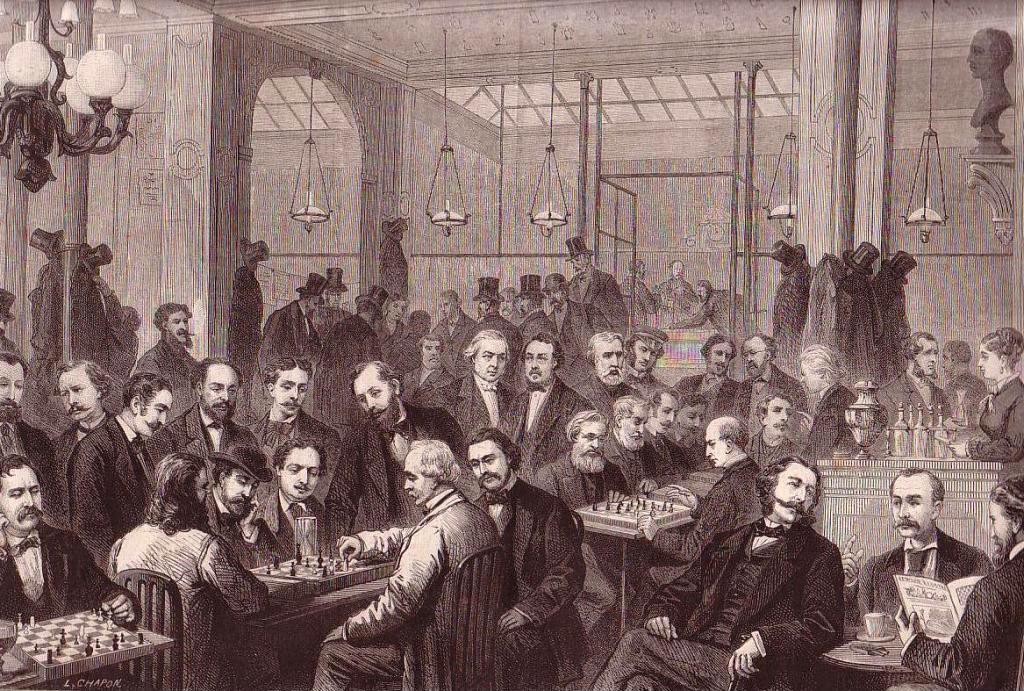Part 1: A gigantic deception
The omnipresent Jorge Luis Borges, who was a big admirer of Poe, once said: "Behind Poe (as behind Swift, Carlyle, Almafuerte) there is a neurosis. Interpreting his work based on that anomaly can be abusive or legitimate. It is abusive when the neurosis is alleged to invalidate or deny the work; it is legitimate when one looks into neurosis as a means to understand the work's genesis". Well, let us take in his words and not fall into the pitfalls he warned us about.
Let us begin by pointing out a fact that is incontestable: it should not go unnoticed, or be considered a minor issue, that such an intellectual devoted so much attention to the game of chess, despite the brutal interpellation he — at times — put forth against it. So, in the following lines, we will try to unravel the scope of Poe's diatribe against our dear game.
His first approach to the matter, which might have been crucial to his conceptualisation of the game, was not exactly pleasant and was tainted by a farce — that of the Automaton Chess Player. It was a device that supposedly — as was as assured in the theatrical performances that raged at the time (with a commercial purpose, of course) — could actually play on its own.
Poe verified that everything was based on a gigantic deception, as was documented in Mäelzels's Chess Player, an essay published in April 1836 in the Southern Literary Messenger, an American literary magazine from Richmond, Virginia.
The writer supposed — demonstrated in all fairness — that behind the attractive machine that interacted with those brave enough to face it — and whom he usually defeated — hid a player, who was of course very gifted. (It suffered one of its few losses in the United States against a woman with the surname Fischer...a premonition?) Therefore, the machine would amaze the public with its strength.

A possible explanation of The Turk's functioning | Drawing: Joseph Racknitz
The artefact was known as The Turk, due to the appearance of the non-human figure that (only in theory) played the game. It was also known as Mäelzel's ingenious machine, a name given in honour to the Austrian engineer who popularised it.
 He was a child prodigy and he is surrounded by legends. In his best times he was considered to be unbeatable and by many he was reckoned to be the greatest chess talent of all time: Jose Raul Capablanca, born 1888 in Havana.
He was a child prodigy and he is surrounded by legends. In his best times he was considered to be unbeatable and by many he was reckoned to be the greatest chess talent of all time: Jose Raul Capablanca, born 1888 in Havana. The reference is to Johann Nepomuk Mäelzel (1772-1838) who, strictly speaking, was far from the inventor — he only appropriated it. It has been speculated that he stole it from the son of the actual inventor, the Hungarian Baron Wolfgang von Kempelen (1734-1804), once he died. Mäelzel was an engineer and had previously another invention of a colleague attributed to his name: a metronome, which was relatively popular at the time. He, in fact, made some mechanical modifications that improved the machine.
The automaton originally emerged as an amazing and lucrative spectacle in Central Europe — at the Viennese court — towards the end of the eighteenth century. Its debut took place in 1770 at the beautiful Schönbrunn Palace in the capital of the Austro-Hungarian Empire.
The machine was presented in different parts of the continent. It played against many notable personalities, such as Empress Maria Theresa of Austria, Frederick the Great of Prussia, King Louis XVIII of France, Napoleon Bonaparte and Benjamin Franklin. Later, it would cross the Atlantic and make appearances during the 19th century in the USA and Cuba, where Poe got to know it.
The first time it was presented on American soil was in 1826, at Broadway's National Hotel in New York, with unusual success, as the room was packed at every daily appearance. The national tour continued, and Poe personally met The Turk when it arrived in Richmond.
Although there always were suspicions, in May 1827, during a show in Baltimore, the truth began to show. Two children, who were spying from a door in the auditorium, discovered Schlumberger — the chess player hidden inside, who supposedly officiated as Mäezel's secretary — emerging from the cabinet built into the artefact after the performance.
 The "Mega" is the database every serious chessplayer needs. The database contains 7.1 million games from 1500 to 2017, in highest quality standard, full of top level analyses and completely classified.
The "Mega" is the database every serious chessplayer needs. The database contains 7.1 million games from 1500 to 2017, in highest quality standard, full of top level analyses and completely classified.
The Turk was a mystery | Author: Joseph Racknitz
The case would soon be forgotten, and the con artist continued his adventures in America, deceiving many, as he had been doing for so long, even in European courts. However, he was not able to entrap Poe's brilliant mind.
Although the writer did not exactly unveil the mechanism that controlled the device from within, he demonstrated, in a concise and irrefutable way, that the machine could only be operated by a person located inside. The idea of any sort of automatic mechanism driving the device was a complete farce.
He begins his argument thus:
Perhaps no exhibition of the kind has ever elicited so general attention as the Chess-Player of Maelzel. Wherever seen it has been an object of intense curiosity, to all persons who think. Yet the question of its modus operandi is still undetermined. Nothing has been written on this topic which can be considered as decisive — and accordingly we find every where men of mechanical genius, of great general acuteness, and discriminative understanding, who make no scruple in pronouncing the Automaton a pure machine, unconnected with human agency in its movements, and consequently, beyond all comparison, the most astonishing of the inventions of mankind.
Poe supports his arguments with some interesting analogies with other automated systems, mentioning the carriage invented by Camus for the amusement of a young Louis XIV in France; the magician built by Maillardet, specialised in answering certain questions; the real-size duck created by Vaucanson, which perfectly imitated a living animal; and Babbage's machine, which could not only compute astronomical and navigation tables to any given extent, but also render the exactitude of its operations mathematically and correct its possible errors. Using these paradigms as a starting point, Poe tests the thesis that Mäezel's chess machine was actually an automaton. The thesis was completely undermined, as has been already mentioned.

In this context, he makes a first assessment about chess, comparing it to mathematics, which of course favours the latter. When commenting on the subject of scientific evidence, he says that in chess, unlike in mathematics:
...there is no determinate progression. No one move in chess necessarily follows upon any one other. From no particular disposition of the men at one period of a game can we predicate their disposition at a different period. Let us place the first move in a game of chess, in juxta-position with the data of an algebraical question, and their great difference will be immediately perceived. From the latter — from the data — the second step of the question, dependent thereupon, inevitably follows. It is modelled by the data. It must be thus and not otherwise.
Conversely, in the game, he observes that:
...from the first move in the game of chess no especial second move follows of necessity. In the algebraical question, as it proceeds towards solution, the certainty of its operations remains altogether unimpaired. The second step having been a consequence of the data, the third step is equally a consequence of the second, the fourth of the third, the fifth of the fourth, and so on, and not possibly otherwise, to the end. But in proportion to the progress made in a game of chess, is the uncertainty of each ensuing move. A few moves having been made, no step is certain.
After these digressions, entering fully into the question of the automaton, he makes a precise description of its characteristics, based on what he observed and what he researched about its history. He specifically mentions its presentations in North America, assuring: "Of late years it has visited the principal towns in the United States. Wherever seen, the most intense curiosity was excited by its appearance, and numerous have been the attempts, by men of all classes, to fathom the mystery of its evolutions".
In a highly descriptive manner, he explains:
At the hour appointed for exhibition, a curtain is withdrawn, or folding doors are thrown open, and the machine rolled to within about twelve feet of the nearest of the spectators, between whom and it (the machine) a rope is stretched. A figure is seen habited as a Turk, and seated, with its legs crossed, at a large box apparently of maple wood, which serves it as a table. The exhibiter will, if requested, roll the machine to any portion of the room, suffer it to remain altogether on any designated spot, or even shift its location repeatedly during the progress of a game. The bottom of the box is elevated considerably above the floor by means of the castors or brazen rollers on which it moves, a clear view of the surface immediately beneath the Automaton being thus afforded to the spectators. The chair on which the figure sits is affixed permanently to the box. On the top of this latter is a chess-board, also permanently affixed. The right arm of the Chess-Player is extended at full length before him, at right angles with his body, and lying, in an apparently careless position, by the side of the board. The back of the hand is upwards. The board itself is eighteen inches square. The left arm of the figure is bent at the elbow, and in the left hand is a pipe. A green drapery conceals the back of the Turk, and falls partially over the front of both shoulders. To judge from the external appearance of the box, it is divided into five compartments — three cupboards of equal dimensions, and two drawers occupying that portion of the chest lying beneath the cupboards.
[...] Maelzel now informs the company that he will disclose to their view the mechanism of the machine. Taking from his pocket a bunch of keys he unlocks with one of them, door marked 1 in the cut above, and throws the cupboard fully open to the inspection of all present. Its whole interior is apparently filled with wheels, pinions, levers, and other machinery, crowded very closely together, so that the eye can penetrate but a little distance into the mass. Leaving this door open to its full extent, he goes now round to the back of the box, and raising the drapery of the figure, opens another door situated precisely in the rear of the one first opened. Holding a lighted candle at this door, and shifting the position of the whole machine repeatedly at the same time, a bright light is thrown entirely through the cupboard, which is now clearly seen to be full, completely full, of machinery. The spectators being satisfied of this fact, Maelzel closes the back door, locks it, takes the key from the lock, lets fall the drapery of the figure, and comes round to the front.
By following this narrative, we seem to have travelled in time and space and to be ourselves part of the crowd in one of the rooms where the automaton made one of its regular presentations. The strength of conviction of Poe's description achieved that magical effect.
Poe, who was first fascinated, like all the spectators, following The Turk's moves, left the field of sensations, went into the field of reason and tried to find an answer. He wanted to know for sure if he had been an object of deception — of a mere act of sleight of hand — or if he had witnessed, as one might suppose, one of the greatest discoveries ever generated by humankind.
So, after all, by evidencing that within the automaton hid a person of flesh and blood who was materially and mentally responsible for operating the device and who was, ultimately, playing chess, far from being considered a magic trick, was ascribed to the field of deception and manipulation of the spectators. Poe, who could not and would not allow the lie to remain unpunished, unravelled the mystery to his contemporaries and, at the same time, gave a lesson in rationality and morality.

Poe was aware of an extensive document printed in Paris in 1785, in which the author laid out the hypothesis that it was a dwarf who manipulated the machine, which the American considered absurd.
He then alludes to a book published in 1789 in Dresden, Germany, where Freyher states that, "...an intelligent boy, very thin and tall for his age (enough to fit in a drawer placed under the board) played the game of chess and made all the movements of the automaton". This idea was also discarded by Poe.
However, he accepted — partially — the explanation contained in a Baltimore weekly, under the title 'An attempt to analyse the Automaton Chess-Player of M. Maelzel', of which he states:
The solution consists in a series of minute explanations, (accompanied by wood-cuts, the whole occupying many pages) in which the object is to show the possibility of so shifting the partitions of the box, as to allow a human being, concealed in the interior, to move portions of his body from one part of the box to another, during the exhibition of the mechanism — thus eluding the scrutiny of the spectators.
After punctually analysing the pros and cons of the various hypotheses, Poe affirms, convincingly, that the only thing that is definitely true is that there is a person hidden inside a cabinet during the whole exhibition. His conclusion is based on the following detailed observations:
1. The moves of the Turk are not made at regular intervals of time, but accommodate themselves to the moves of the antagonist — although this point (of regularity) so important in all kinds of mechanical contrivance, might have been readily brought about by limiting the time allowed for the moves of the antagonist. For example, if this limit were three minutes, the moves of the Automaton might be made at any given intervals longer than three minutes. The fact then of irregularity, when regularity might have been so easily attained, goes to prove that regularity is unimportant to the action of the Automaton — in other words, that the Automaton is not a pure machine.
2. When the Automaton is about to move a piece, a distinct motion is observable just beneath the left shoulder, and which motion agitates in a slight degree, the drapery covering the front of the left shoulder. This motion invariably precedes, by about two seconds, the movement of the arm itself — and the arm never, in any instance, moves without this preparatory motion in the shoulder. Now let the antagonist move a piece, and let the corresponding move be made by Maelzel, as usual, upon the board of the Automaton. Then let the antagonist narrowly watch the Automaton, until he detect the preparatory motion in the shoulder. Immediately upon detecting this motion, and before the arm itself begins to move, let him withdraw his piece, as if perceiving an error in his manœuvre. It will then be seen that the movement of the arm, which, in all other cases, immediately succeeds the motion in the shoulder, is withheld — is not made — although Maelzel has not yet performed, on the board of the Automaton, any move corresponding to the withdrawal of the antagonist. In this case, that the Automaton was about to move is evident — and that he did not move, was an effect plainly produced by the withdrawal of the antagonist, and without any intervention of Maelzel.
This fact fully proves, 1 — that the intervention of Maelzel, in performing the moves of the antagonist on the board of the Automaton, is not essential to the movements of the Automaton, 2 — that its movements are regulated by mind — by some person who sees the board of the antagonist, 3 — that its movements are not regulated by the mind of Maelzel, whose back was turned towards the antagonist at the withdrawal of his move.
3. The Automaton does not invariably win the game. Were the machine a pure machine this would not be the case — it would always win. The principle being discovered by which a machine can be made to play a game of chess, an extension of the same principle would enable it to win a game — a farther extension would enable it to win all games — that is, to beat any possible game of an antagonist. A little consideration will convince any one that the difficulty of making a machine beat all games, is not in the least degree greater, as regards the principle of the operations necessary, than that of making it beat a single game. If then we regard the Chess-Player as a machine, we must suppose, (what is highly improbable,) that its inventor preferred leaving it incomplete to perfecting it — a supposition rendered still more absurd, when we reflect that the leaving it incomplete would afford an argument against the possibility of its being a pure machine — the very argument we now adduce.
4. When the situation of the game is difficult or complex, we never perceive the Turk either shake his head or roll his eyes. It is only when his next move is obvious, or when the game is so circumstanced that to a man in the Automaton’s place there would be no necessity for reflection. Now these peculiar movements of the head and eyes are movements customary with persons engaged in meditation, and the ingenious Baron Kempelen would have adapted these movements (were the machine a pure machine) to occasions proper for their display — that is, to occasions of complexity. But the reverse is seen to be the case, and this reverse applies precisely to our supposition of a man in the interior. When engaged in meditation about the game he has no time to think of setting in motion the mechanism of the Automaton by which are moved the head and the eyes. When the game, however, is obvious, he has time to look about him, and, accordingly, we see the head shake and the eyes roll.
5. When the machine is rolled round to allow the spectators an examination of the back of the Turk, and when his drapery is lifted up and the doors in the trunk and thigh thrown open, the interior of the trunk is seen to be crowded with machinery. In scrutinizing this machinery while the Automaton was in motion, that is to say while the whole machine was moving on the castors, it appeared to us that certain portions of the mechanism changed their shape and position in a degree too great to be accounted for by the simple laws of perspective; and subsequent examinations convinced us that these undue alterations were attributable to mirrors in the interior of the trunk. The introduction of mirrors among the machinery could not have been intended to influence, in any degree, the machinery itself. Their operation, whatever that operation should prove to be, must necessarily have reference to the eye of the spectator. We at once concluded that these mirrors were so placed to multiply to the vision some few pieces of machinery within the trunk so as to give it the appearance of being crowded with mechanism. Now the direct inference from this is that the machine is not a pure machine. For if it were, the inventor, so far from wishing its mechanism to appear complex, and using deception for the purpose of giving it this appearance, would have been especially desirous of convincing those who witnessed his exhibition, of the simplicity of the means by which results so wonderful were brought about.
6. The external appearance, and, especially, the deportment of the Turk, are, when we consider them as imitations of life, but very indifferent imitations. The countenance evinces no ingenuity, and is surpassed, in its resemblance to the human face, by the very commonest of wax-works. The eyes roll unnaturally in the head, without any corresponding motions of the lids or brows. The arm, particularly, performs its operations in an exceedingly stiff, awkward, jerking, and rectangular manner. Now, all this is the result either of inability in Maelzel to do better, or of intentional neglect — accidental neglect being out of the question, when we consider that the whole time of the ingenious proprietor is occupied in the improvement of his machines. Most assuredly we must not refer the unlife-like appearances to inability — for all the rest of Maelzel’s automata are evidence of his full ability to copy the motions and peculiarities of life with the most wonderful exactitude. The rope-dancers, for example, are inimitable. When the clown laughs, his lips, his eyes, his eye-brows, and eye-lids — indeed, all the features of his countenance — are imbued with their appropriate expressions. In both him and his companion, every gesture is so entirely easy, and free from the semblance of artificiality, that, were it not for the diminutiveness of their size, and the fact of their being passed from one spectator to another previous to their exhibition on the rope, it would be difficult to convince any assemblage of persons that these wooden automata were not living creatures. We cannot, therefore, doubt Mr. Maelzel’s ability, and we must necessarily suppose that he intentionally suffered his Chess-Player to remain the same artificial and unnatural figure which Baron Kempelen (no doubt also through design) originally made it. What this design was it is not difficult to conceive. Were the Automaton life-like in its motions, the spectator would be more apt to attribute its operations to their true cause, (that is, to human agency within) than he is now, when the awkward and rectangular manœuvres convey the idea of pure and unaided mechanism.
7. When, a short time previous to the commencement of the game, the Automaton is wound up by the exhibiter as usual, an ear in any degree accustomed to the sounds produced in winding up a system of machinery, will not fail to discover, instantaneously, that the axis turned by the key in the box of the Chess-Player, cannot possibly be connected with either a weight, a spring, or any system of machinery whatever. The inference here is the same as in our last observation. The winding up is inessential to the operations of the Automaton, and is performed with the design of exciting in the spectators the false idea of mechanism.
8. When the question is demanded explicitly of Maelzel — “Is the Automaton a pure machine or not?” his reply is invariably the same — “I will say nothing about it.” Now the notoriety of the Automaton, and the great curiosity it has every where excited, are owing more especially to the prevalent opinion that it is a pure machine, than to any other circumstance. Of course, then, it is the interest of the proprietor to represent it as a pure machine. And what more obvious, and more effectual method could there be of impressing the spectators with this desired idea, than a positive and explicit declaration to that effect? On the other hand, what more obvious and effectual method could there be of exciting a disbelief in the Automaton’s being a pure machine, than by withholding such explicit declaration? For, people will naturally reason thus, — It is Maelzel’s interest to represent this thing a pure machine — he refuses to do so, directly, in words, although he does not scruple, and is evidently anxious to do so, indirectly by actions — were it actually what he wishes to represent it by actions, he would gladly avail himself of the more direct testimony of words — the inference is, that a consciousness of its not being a pure machine, is the reason of his silence — his actions cannot implicate him in a falsehood — his words may.
Not conforming to these precise observations, the author gave more arguments to demonstrate the fiasco. He goes as far as to indicate that a medium-size person — or even somehow tall — could be locked in the box, differing from the theories previously held that only a dwarf or a child could be the author of the moves made by the automaton.
In short, Poe speculates — and this is perfectly true — that the man inside the artefact was a member of Mäezel's team who did not have, at least noticeably, other occupation than that of helping him pack and unpack the automaton.
That person was of more or less average height and his shoulders were notably bent down. Today we know for a fact that the man was (as briefly mentioned above) William Schlumberger (1800-1838), a German player who frequented the Café de la Regénce in Paris, where he played against Louis-Charles Mahé de La Bourdonnais (1795-1840), the best chess player of the time, and who mentored Pierre Charles Fournier de Saint-Amant (1800-1872), who later became another illustrious player.

Café de la Regence in 1874 | Author: M. Horsin-Déon
The German was hired to be the brain behind The Turk, for which he charged about fifty dollars per month plus expenses. He held this post without interruption until he died in 1838 in Havana, a victim of yellow fever, while touring with the automaton. His death, the device catching fire and Poe's speculations were the beginning of the end for a farce that had lasted way too long.
Poe thus managed to unveil the truth. His reasoning led him to reveal a fantasy that came from far away, both in time and space. The writer later gave birth to other fantasies, within the frame of his works in poetry and with his short stories. These exist, however, in the field of fiction and not in that of a supposed reality, like the one proposed by a chess automaton that, in short, was nothing but a gigantic deception.
Continued in part two...
Links




























